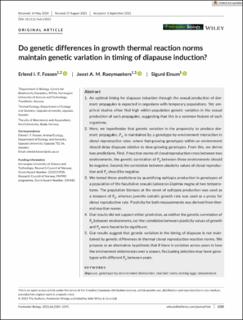| dc.description.abstract | An optimal timing for diapause induction through the sexual production of dormant propagules is expected in organisms with temporary populations. Yet, empirical studies often find high within-population genetic variation in the sexual production of such propagules, suggesting that this is a common feature of such organisms.
Here, we hypothesize that genetic variation in the propensity to produce dormant propagules, Pd, is maintained by a genotype-by-environment interaction in clonal reproductive rates, where fast-growing genotypes within an environment should delay diapause relative to slow-growing genotypes. From this, we derive two predictions. First, if reaction norms of clonal reproduction cross between two environments, the genetic correlation of Pd between these environments should be negative. Second, the correlation between plasticity values of clonal reproduction and Pd should be negative.
We tested these predictions by quantifying ephippia production in genotypes of a population of the facultative sexual cladoceran Daphnia magna at two temperatures. The population biomass at the onset of ephippia production was used as a measure of Pd, whereas juvenile somatic growth rate was used as a proxy for clonal reproductive rate. Plasticity for both measurements was derived from thermal reaction norms.
Our results did not support either prediction, as neither the genetic correlation of Pd between environments, nor the correlation between plasticity values of growth and Pd were found to be significant.
Our results suggest that genetic variation in the timing of diapause is not maintained by genetic differences in thermal clonal reproduction reaction norms. We propose as an alternative hypothesis that if there is variation across years in how the environment deteriorates over a season, fluctuating selection may favor genotypes with different Pd between years. | en_US |

